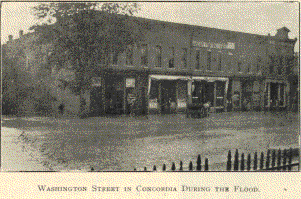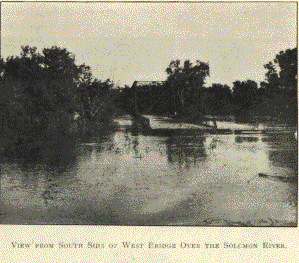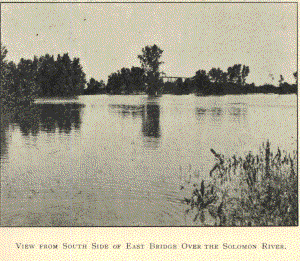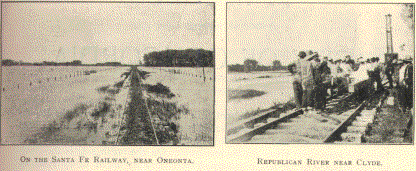Phenomena and idiosyncracies of Kansas, as furnished by the various old settlers, is of more than passing interest.
In 1869, the eastern part of Cloud county changed from buffalo grass to blue joint and sage grass. These new grasses marched forward each succeeding year, the buffalo grass disappearing as they advanced, but it was observed if the blue joint pastures were over-stocked the land would go back to buffalo grass again and presumably would stay there for all time if sufficiently pastured and tramped.
In 1870 Doctor Laughlin's (Clyde) farm was covered with buffalo grass, with no other kind of vegetation to be found. A black-glove could have been seen from the western line on any part of his land. The following year. 1871, a thousand sheep could have been hidden from view on the same ground by the heavy growth of blue joint. Buffalo grass will stand more drouth than any of the grasses and its very existence seems to depend upon abuse, over-taxation and tramping. When the millions of buffalo were driven back it sickened and died, other grasses taking its place. It seems to flourish under oppression, to wither and perish under civilization. Most of the old settlers of Cloud county have observed another strange freak in the pastures which succeeded the buffalo grass. If the prairie were burned over in February or March, it would be covered with sage grass, if burned in May it would be covered with blue joint, no difference which grass covered the prairie the previous year. If ground covered with sage grass were burned over in May it would be covered with blue joint, but if burned in March it would be covered with the same kind of grass burned - sage grass. This phenomena is most remarkable when we consider that the two grasses are entirely different species.
In 1870, there was a well dug on Doctor Laughlin's farm fifty-four feet deep. This year his land was covered with buffalo grass and scarcely any other kind of plant growth could be found. The following year thirty- four distinct varieties were found upon the excavated dirt from the well. This vegetation was minature, four to six inches in length, mostly vines covered with small blossoms from one-sixteenth to one-fourth of an inch in diameter, white and blue being the only colors represented. Earth exhumed from a great depth will grow the same differentiated varieties now as then.
It was also observed in the early settlement of the country that lands of the same fertility and inspiring would vary in production from six to twelve bushels per acre, depending upon the time and depth of breaking. Deep breaking would fall short in production from twelve to fifteen bushels, and no one seems to know why a few days difference in plowing will make quite a difference in the yield per acre.
Mr. Payer states that his boy stopped plowing on account of an approaching storm and resumed plowing the next day. The difference in the yield could be seen to the very furrow where he stopped before the storm. Almost every farmer has noticed that a very few days difference in planting his crop will make a great difference in the yield.
Doctor Laughlin experimented with dynamite in the interest of horticulture in 1887. It was thought when the ground was frozen to its greatest depth would be the best time for the experiment, hence the last of February was chosen. Holes were bored from two to eight feet deep and from two to eight ounces of dynamite was used in each, one ounce to the foot being the rule. It was discovered that a hole three feet deep (just under the frozen ground) with three ounces of dynamite immediately after explosion would take in over one hundred gallons of water, the ground being broken up from five to eight feet in every direction. For many miles around the farmers came to see the experiment, and from among them was chosen a committee, which reported favorably, stating in their report there was no doubt but that dynamiting of the ground would be of immense value in tree planting, and if applied when frozen to the depth of two feet it would be of still greater value in agriculture, the cost being about fourteen dollars per acre, using one charge to a rod square. But for orchard planting the ground should be frozen to its greatest depth and the cost per tree of dynamiting would be from two and one-half to four cents.
During the early settlement of the country "Greenback" Williams, of Buffalo township, operated a stone quarry in Jewell county and burned lime for the settlers. Imbedded among the stone were numerous petrified turtles of various sizes, often times aggregating a wagon load in enough material to burn a kiln of lime. They seemed to have gathered in that particular locality in schools, for there were hundreds of them. They had been deposited there in another era, for the ground is high and remote from any stream.
When digging a well on the original homestead of a niece of William H. Page, the farm now known as the Richardson place, they found at a depth of about nine feet below the surface in a strata of soft sandstone the short rib bones of what was supposed to be those of all animal imbedded in the rock.
In the latter part of July, 1872, W. Day, who lived ten miles northwest of Concordia, and some hired assistants were digging a cistern, when they came in contact with a large rock, which, being a hindrance to the proceeding of their work, they attempted to remove it. Falling to loosen or make any impression upon the stone they examined it more closely, when they discovered the quality of rock was of a different character from what they had previously found, and proceeded to break it in pieces in order to remove it more easily. A moment later one of the workmen gave vent to an exclamation of surprise, which brought the others to his side, whereupon was clearly outlined the petrified fins of a fish on the side of the rock. After displacing the stone they fitted the pieces together and found the matter to be a huge fish that measured eight feet in length and six feet around the body.
A remarkable phenomena is connected with the hot winds of Kansas, sometimes designated electrical storms, which no scientist has ever been able to explain. In a field of corn that is practically of the same level, and the plant uniform in growth, alternate rows of ten or fifteen will be blasted, burned beyond recovery, while the intervening tract will be unharmed. Nicholas French and his son Markel were plowing one windy day when an irregular tract was mown to the earth by one of the so-called electrical winds, while other parts of the field were not affected whatever.
A company was formed in the 'seventies for the purpose of investigating the salt veins in the marsh. When down at a depth of about twenty-eight feet they struck a walnut log in a good state of preservation. The circumstance is more peculiar because of the fact there was not a walnut tree within a radius of several miles from this point. When down about sixty-seven feet they encountered a strong flowing vein which was too salty for drinking, but would not yield a large enough per cent for manufacturing purposes. The water continues to flow. The well is on the farm of C.N. Baldwin, who dug a well about thirty rods from the one mentioned and found an excellent quality of fresh water at a depth of ten feet. In the early days of Kansas the settlers' wives cured their cucumbers for table use in the brine from the salt marsh.
During the summer of 1870, when not a ton of hay could be cut in a whole township on the uplands, although not accompanied with hot winds, the cattle, what few there were, comparatively speaking, were never fatter. The dry grass was full of nutriment and the stock preferred it to the new grasses just coming up out of the earth or that which was three to five inches high in the sloughs.
The perennial ragweed is a native of Kansas and grows rampantly everywhere but the annual plant was not known in this locality until about ten years ago. It was in all probability brought into the country with other seeds or cereals. The dandelion and other plants were introduced in a similar manner.
This association was organized in 1895. In the beginning the intention was to include the old timers of the townships of Aurora, Colfax, Oakland and Nelson. They held several reunions, which were very enjoyable and served to keep fresh in the memory and keep alive the ties of friendship formed when the country was new and sparsely settled, and when all were neighbors within a radius of many miles.
The board of officials were W.M. Durkee, of Aurora; W.C. Campbell, Colfax township; H.R. Honey, Concordia, and Mrs. Evelyn Bradford. The last meeting was held in Oakland township on Pipe creek, in 1900, at Cable's grove, one and one-half miles south of Aurora. The grove was decorated with patriotic symbols, mottoes and antique furniture. The address of welcome was delivered by that old veteran and pioneer, J.E. Burkhart. William Durkee was elected president for the ensuing year, and J.E. Burkhart, secretary.
In 1885 J.M. Hagaman took initiatory measures in moving for an old settlers' reunion and suggested they celebrate July 3rd of that year as a beginning of a permanent organization. None of these organizations were of permanent duration.
It was for several years a custom prevalent over the state to prepare a local history of the county to be read on July 4, and published in various newspapers, and upon an occasion of this kind, July 4, 1876, Eugene Ware (the well known Kansas poet) read the following poem:
|
"He who lived in Kansas, though he roam, Can find no other spot and call it home. As Ingalls says, the Kansas man may stray, May live, perchance depart or go away. In short, may roam, but be it anywhere, He must return if he can raise the fare.
On July Fourth we always float the flag,
0, grand old bird! o'er many a weary mile |
Cloud county has a miniature "Kansas Day Club," with headquarters in Concordia. It is along the same lines as the state organization. It is a young men's Republican club. Sidney H. Knapp has reason to be proud of the fact that he is the instigator and organizer of this club. F.W. Sturges, son of Judge Sturges, of Concordia, is president, and Sidney H. Knapp, of Clyde, secretary and treasurer.
They arrange that the principal speakers at their banquets shall be natives of the county. There is a similar club in Dickinson county; this and the one in Cloud county are the only organizations of this kind at present, but it is presumed others will follow.
They gave a banquet March 26, 1002, to about four hundred people, which was one of the most elaborate functions ever given in Concordia, and in fact few functions excel it in the state. Fred Sturges, Jr., was toastmaster and to his untiring efforts and good management credit is due for the success of the banquet. The speeches made were as follows: "A Few Remarks," Governor Stanley; "The Young Man in Politics," Charles A. Case; "Our Sister County," C.A. Kimball; "Concerning Cloud County," Albert T. Reid; The Concordia Male Quartet; "The Backbone of the Nation," 0.E. Hardesty; "Why Should a Young Man Be in Politics," Doctor J.L. Kirby; "Political Manhood," J.B. Wood; "Kansas," Senator Burton, the latter coming all the way from Washington, District of Columbia, to attend this occasion.
One of the notable features of this banquet was the absence of wine. The menu card was headed with the following quotation: "Some food we have and some water fresh."
The object of the organization is to promote Republicanism and to call together in a social way the young Republicans of Cloud county.
 The Pike monument commemorates the place and event where Colonel Zebulon
Pike, while on his return from Mexico, raised the American flag, the first stars
and stripes that ever floated over Kansas soil.
The Pike monument commemorates the place and event where Colonel Zebulon
Pike, while on his return from Mexico, raised the American flag, the first stars
and stripes that ever floated over Kansas soil.
The cornerstone was placed with ceremonial rites by the Grand Lodge, Free and Accepted Masons, under the auspices of Bellville Lodge No. 129, July 4, 1901. The unveiling of the monument occurred the following 29th of September, just ninety-five years from the day Colonel Pike displayed the fair standard of American liberty on Pawnee rock, the site of the Pawnee Indian village in Republic county.
Cloud county once had a prosperous County Fair Association. The society was organized in 1883. A considerable sum of money was expended in fitting up the grounds that the agricultural and mechanical products might be shown to good advantage. It was a commendable institution and flourished several years. Competent and reliable men were in charge and the people from all over the surrounding country took an appreciable interest. The grounds, which were situated near Concordia, afforded one of the best race tracks in northwest Kansas. The advantages of the state as a productive and stock raising country were sent abroad and did much to convince eastern people, who entertained grave doubts about even the civilization of the state, that Kansas had no superior in the west.

During the latter part of the month of June, 1902, scores of fields adjacent to the rivers and creeks were submerged under water caused by the heavy and continued rainfalls, seriously damaging the corn and many of the wheat fields. As the injured grain ripened the fields were in such a muddy condition it was impossible in many instances to garner the grain. Both the Republican and Solomon rivers were higher than they had been known for years, as the illustrations given will testify, and in July, 1902, the Republican was reported to have been higher than ever before in the history of the country, reaching a width of four miles in some localities. The tracks of the Prosser branch of the Missouri Pacific Railway, near Yuma, about four miles west of Concordia, were under water for several miles and hundreds of yards of track was washed out.

View from south side of west bridge
over the Solomon River.

View from the south side of east
bridge over the Solomon River.

On the Santa Fe Railway, near Oneonta. & Republican River near Clyde.
Many farmers living In the lowlands were compelled to flee to the uplands for safety; many of them losing stock. Some of the harvesting had been finished; some of the grain was unripe, owing to a late season, drouth, etc., and a machine did not enter the field. The young and growing corn that had given such rare promise of a plentiful harvest was greatly injured, some places totally. The watermelon growers in the vicinity of Clyde were heavy losers of their crop of melons, which gave indications of all unprecedented yield a few weeks before. The farmer who lives on the upland in a year like this can witness his broad acres of wheat or his great fields of corn, the stocks of which are burdened with long ears of well-filled corn, and feel it is good to live on the upland prairie.

Transferring cream across the Republican River.
The cut on page 148 is a view of the "Bridge" road (taken July 9), looking south from the Missouri Pacific railway crossing, between Shorer's and Fessenden's farms, during the recent high water - the highest the Republican river has been during the past twenty-five years - at which time and place the river was nearly two miles wide. It also illustrates how one of Clyde's principal business men overcame the obstacle presented in the obstruction of communication. Mr. C.F. Armstrong makes the proud claim that he has never, for any reason, closed down any of his skimming stations, and never proposes to as long as his patrons will furnish him any milk. During this time the Como (Mulberry) station was receiving from twelve thousand to fifteen thousand pounds of milk daily. The cream from this milk, together with that from Huscher and Concordia, was brought to the south side of Fessenden's farm, from whence it was successfully transported across the river in a boat, necessitating many trips and much arduous and dangerous labor. Each load had to be pulled by hand over the Missouri Pacific railway, but as the tops of the rails were only a few niches above the general surface of the river, this was not the most difficult part of the work.
![]()
Transcribed from E.F. Hollibaugh's Biographical history of Cloud County, Kansas biographies of representative citizens. Illustrated with portraits of prominent people, cuts of homes, stock, etc. [n.p., 1903] 919p. illus., ports. 28 cm.
New Index
A | B | C | D | E | F | G | H | I | J | K | L | M | N | O | P | Q | R | S | T | U | V | W | Y | Z
